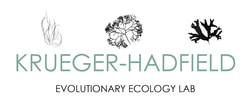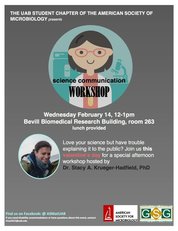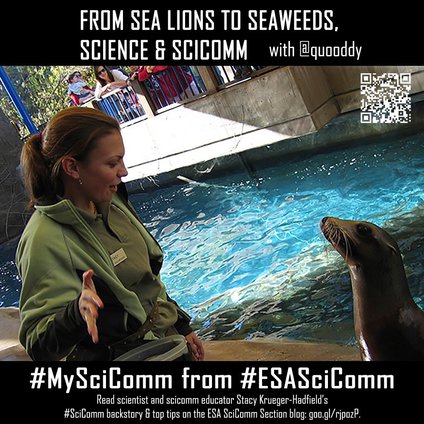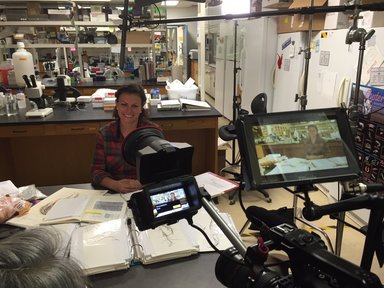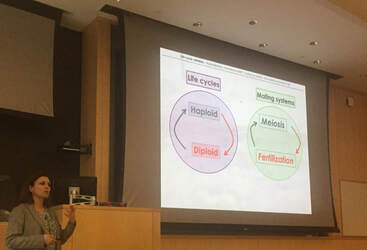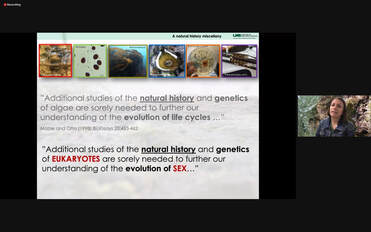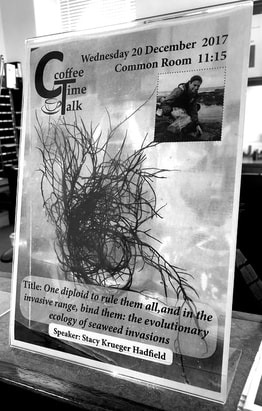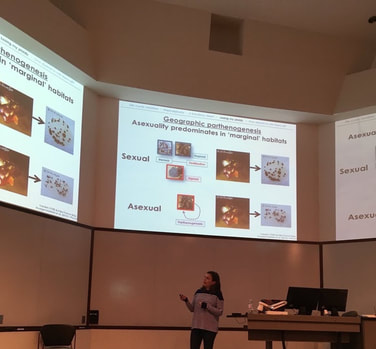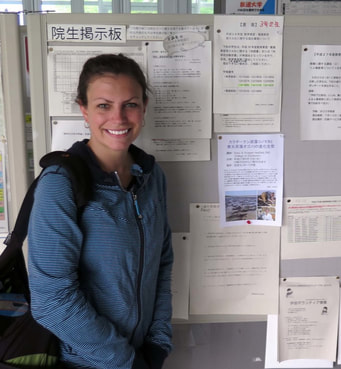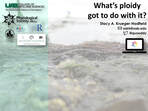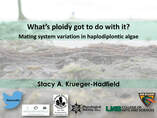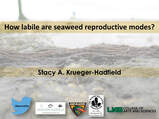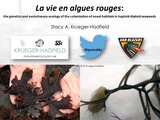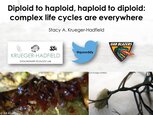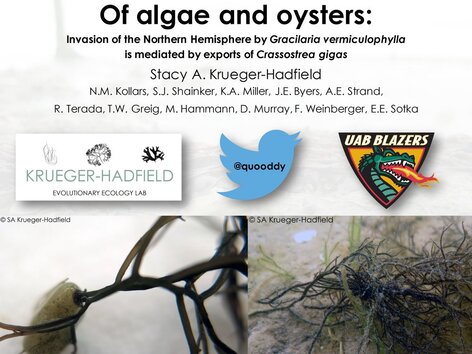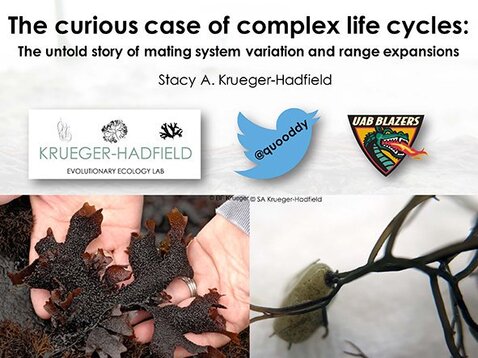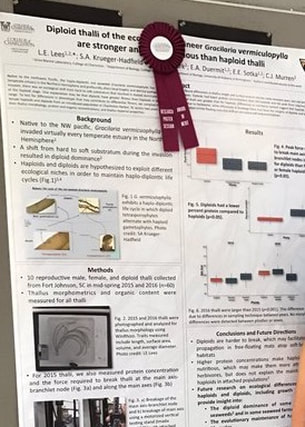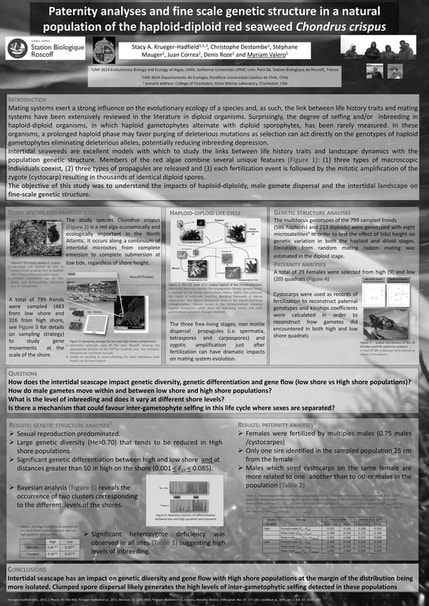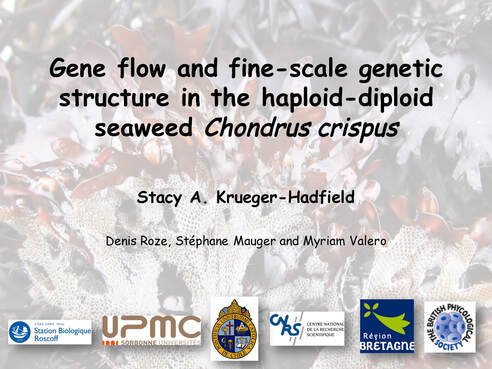Outreach and Service
The Molecular Ecologist
Since 2014, Stacy have been a regular contributor to The Molecular Ecologist. If you are interested in reading Stacy's posts, visit the blog here.
Stacy also wrote an edited, commissioned piece on why zoos matter to ecologists and her personal narrative to academia, see it here.
Stacy also wrote an edited, commissioned piece on why zoos matter to ecologists and her personal narrative to academia, see it here.
In 2016, Stacy developed and teaches a science communication course (BY670, BY770) at the University of Alabama at Birmingham. Here are related posts written by Stacy and her students for The Molecular Ecologist:
Gregory S (2020) Where did this flower come from?
Shainker SJ (2020) Genes rolling down the river
Fitch M (2020) It's the city life for me ... or maybe not
O'Connor A (2020) Kelp Connections
Mishra B (2020) Tapping social networks to explore biological systems
Detchemendy T (2020) Yeast 2-Hybrid: discovering protein-protein interactions from yeast to west
Edwards R (2020) Does it pay to be parasitized?
Gregory S (2020) Everything about ant reproductive biology is bizarre
Sirgo C (2020) Bobbing for Bobcats
Walker M (2020) The Virosphere’s Own Trojan HorseMishra B (2020) Tapping social networks to explore biological systems
Oswalt H (2020) Digging for knowledge … and nematodes
Jones A (2020) “Of all the Islands in all the Seas in all the World…”
Gantt S (2020) Brood Parasitism or adoption? Mixed parentage of brooding damselfishes
Krueger-Hadfield SA (2020) #StudentSciComm
Conner N (2019) Snapshots of biodiversity: eDNA as a methodology of species detection
Bonka A (2019) Genetics of returning turtles
Curtis M (2019) The ultimate party animal
Keister E (2019) Is taxonomy still relevant to innovative science?
Heiser S (2019) "Through endurance we conquer*" Are humans really the only ones who can make it across the Drake's Passage?
O'Connor A (2019) Kelp forests: the underwater woodlands
Livett S (2018) Racing against the climate
Jackson J (2018) In it to win it: selective advantage through host-selected mutations
Momeni M (2018) Cricket plays a song of systems biology
Sahawneh K (2018) A master manipulator: how a bacterium tells a plant what to do
Keister E (2018) Are we restoring coral reefs for today or for tomorrow?
Krueger-Hadfield SA (2018) To present data is human, to communicate data is divine
Aida V (2017) Mapping genomes and navigating behavior for wildlife conservation.
Hayes M (2017) Like turtles, terrapin research moves a little slow.
Latimer M (2017) Small Molecules, Big Differences.
Roegner M (2017) Molting on the molecular level: how blue crabs become soft-shell crabs.
Adkins S (2017) Dishing out art: 'Soiling' our microbiology curriculum.
Heiser S (2017) Have we got the power?
Krueger-Hadfield SA (2017) I think we're NOT alone now.
Gregory S (2020) Where did this flower come from?
Shainker SJ (2020) Genes rolling down the river
Fitch M (2020) It's the city life for me ... or maybe not
O'Connor A (2020) Kelp Connections
Mishra B (2020) Tapping social networks to explore biological systems
Detchemendy T (2020) Yeast 2-Hybrid: discovering protein-protein interactions from yeast to west
Edwards R (2020) Does it pay to be parasitized?
Gregory S (2020) Everything about ant reproductive biology is bizarre
Sirgo C (2020) Bobbing for Bobcats
Walker M (2020) The Virosphere’s Own Trojan HorseMishra B (2020) Tapping social networks to explore biological systems
Oswalt H (2020) Digging for knowledge … and nematodes
Jones A (2020) “Of all the Islands in all the Seas in all the World…”
Gantt S (2020) Brood Parasitism or adoption? Mixed parentage of brooding damselfishes
Krueger-Hadfield SA (2020) #StudentSciComm
Conner N (2019) Snapshots of biodiversity: eDNA as a methodology of species detection
Bonka A (2019) Genetics of returning turtles
Curtis M (2019) The ultimate party animal
Keister E (2019) Is taxonomy still relevant to innovative science?
Heiser S (2019) "Through endurance we conquer*" Are humans really the only ones who can make it across the Drake's Passage?
O'Connor A (2019) Kelp forests: the underwater woodlands
Livett S (2018) Racing against the climate
Jackson J (2018) In it to win it: selective advantage through host-selected mutations
Momeni M (2018) Cricket plays a song of systems biology
Sahawneh K (2018) A master manipulator: how a bacterium tells a plant what to do
Keister E (2018) Are we restoring coral reefs for today or for tomorrow?
Krueger-Hadfield SA (2018) To present data is human, to communicate data is divine
Aida V (2017) Mapping genomes and navigating behavior for wildlife conservation.
Hayes M (2017) Like turtles, terrapin research moves a little slow.
Latimer M (2017) Small Molecules, Big Differences.
Roegner M (2017) Molting on the molecular level: how blue crabs become soft-shell crabs.
Adkins S (2017) Dishing out art: 'Soiling' our microbiology curriculum.
Heiser S (2017) Have we got the power?
Krueger-Hadfield SA (2017) I think we're NOT alone now.
The American Genetics Association Blog
Here are related posts written by students for The AGA Blog:
Weddle D (2021) No Hair Dye? No Problem: How CRISPER/Cas 9 alters fur color
Oswalt H (2021) Do male crickets create symphonies?
Whitehead C (2021) NOT Seeing Double: The Gecko Epiphany
O’Connor A (2020) Gene-culture coevolution in humpback whales
Bradley A (2020) What role do pedigrees play in the preservation of the Galapagos giant tortoise?
Ferguson R (2020) Habitat fragmentation of the catfish Hemibagrus spilopterus: damned if we do
Gregory S (2020) The difference 70 miles can make
Thrash R (2020) Do marine species of a fin flock together
Edwards R (2019) Pelagic to Coastal: The expansion of Bottlenose Dolphins
Weddle D (2021) No Hair Dye? No Problem: How CRISPER/Cas 9 alters fur color
Oswalt H (2021) Do male crickets create symphonies?
Whitehead C (2021) NOT Seeing Double: The Gecko Epiphany
O’Connor A (2020) Gene-culture coevolution in humpback whales
Bradley A (2020) What role do pedigrees play in the preservation of the Galapagos giant tortoise?
Ferguson R (2020) Habitat fragmentation of the catfish Hemibagrus spilopterus: damned if we do
Gregory S (2020) The difference 70 miles can make
Thrash R (2020) Do marine species of a fin flock together
Edwards R (2019) Pelagic to Coastal: The expansion of Bottlenose Dolphins
Phycological Society of America
Beginning as a student member in 2010, and continuing to the present as a full member, Stacy have served as a member of the Gerald W. Prescott Award Committee. The Prescott Award recognizes scholarly work in English in the form of a published book or monograph devoted to phycology. See a list of past winners here.
Since 2017, Stacy has been on the PSA Communications Committee, and serves as the associate editor of the PSA Newsletter.
Stacy was elected to the Journal of Phycology Editorial Board and was invited to serve as an Associate Editor in 2018.
Stacy has also served as a Lewin and Bold Award judge for PSA at the annual meeting in 2017, 2018, and 2019.
Since 2017, Stacy has been on the PSA Communications Committee, and serves as the associate editor of the PSA Newsletter.
Stacy was elected to the Journal of Phycology Editorial Board and was invited to serve as an Associate Editor in 2018.
Stacy has also served as a Lewin and Bold Award judge for PSA at the annual meeting in 2017, 2018, and 2019.
Other Science Communication
|
Stacy and her lab were profiled by the Society for the Study of Evolution New Faculty Profiles. Each month SSE highlights two new faculty members and asks them a series of questions about their new labs, experiences, etc.
|
|
In addition to starting a graduate #SciComm course at UAB, Stacy has organized and led other #SciComm training sessions. For Darwin Day 2018, she led two poster training sessions for undergraduates, MS students, and PhD students at UAB. Stacy has also led training sessions for other organizations on campus, such as the UAB chapter of ASM. |
|
Stacy was invited to write a piece for the Ecological Society of America's #MySciComm.
#MySciComm explores the personal and professional journeys of science communicators, including the joys, struggles, and helpful resources that surfaced along their way. #MySciComm also showcases the wide range of types of SciComm that people can do, from photography and illustration to serving as an institutional press officer, doing public engagement research, and so much more. SciComm is an emerging profession, and there are not only a lot of ways of doing SciComm, but a lot of ways of getting into it. Our #MySciComm series highlights some of the possibilities. |
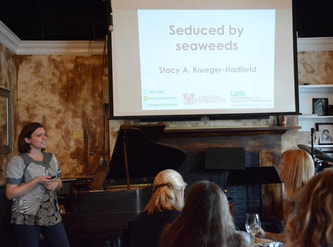
Cultivate started amongst a group of scientists and artists as way to share our passion with others. Stacy led a Cultivate Workshop to get the public interested in seaweeds. She served as the scientist/artist for the evening on "Seduced by Seaweeds in the 21st Century" in which she traced the history of seaweed pressing from Victorian times until the present. Stacy also talked about how important seaweeds are, both ecologically and economically. Afterwards, she taught workshop participants how to press seaweeds.
|
Stacy was interviewed by filmmaker Sandya Viswanathan for her film about The Other 97%. The film is about the scientists that are trying to find and identify Earth’s unknown biodiversity. The problem centers on the 97% of unknown biodiversity. Seaweeds fall into this category! Stacy talked about her work on seaweed mating systems, and seaweed invasions. |
Press
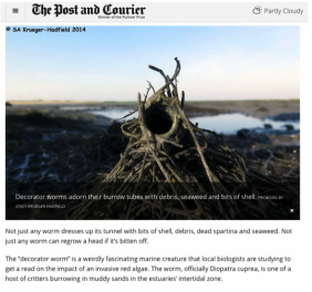
UAB News about the NSF EAGER with Robin Kodner and Trinity Hamilton
First record of golden kelp in Belmullet Mayo Advertiser - article about recent paper in Marine Biodiversity Records on the arrival of Laminaria ochroleuca in Ireland
Scientists puzzled by arrival of invasive seaweed in Co Mayo Irish Times - article about recent paper in Marine Biodiversity Records on the arrival of Laminaria ochroleuca in Ireland
Updates from the Krueger-Hadfield lab UAB Science in Motion - recent articles from the Krueger-Hadfield lab
Marine biologist to export life cycle diversity in red seaweed UAB News - Article about Stacy's Ray Lankester Investigatorship
When invaders go unnoticed UAB Science in Motion - Article on our paper published in Cryptogamie Algologie
US Scientist uses MBA mesocosm to investigate invasive species MBA News Blog - Article about Stacy's Ray Lankester Investigatorship
The MBA is pleased to announce the award of two Ray Lankester Fellowships MBA News Blog - Article about Stacy's Ray Lankester Investigatorship
‘Stylish’ worm studied for the company it keeps, The Post and Courier 20 September 2015 - article about research ongoing in the Sotka lab on the tube building polychaete, Diopatra cuprea, featuring some of Stacy's photography
Mystery in the mudflats, The College Today 21 November 2014 - article highlighting Stacy's collaborations with researchers at CofC
Invasive seaweed may have come from Japanese oysters, The Post and Courier 19 February 2014 - article highlighting Stacy's collaborations with researchers at CofC
Invasive seaweed escapes the farm, The College Today 11 February 2014 - article highlighting Stacy's collaborations with researchers at CofC
First record of golden kelp in Belmullet Mayo Advertiser - article about recent paper in Marine Biodiversity Records on the arrival of Laminaria ochroleuca in Ireland
Scientists puzzled by arrival of invasive seaweed in Co Mayo Irish Times - article about recent paper in Marine Biodiversity Records on the arrival of Laminaria ochroleuca in Ireland
Updates from the Krueger-Hadfield lab UAB Science in Motion - recent articles from the Krueger-Hadfield lab
Marine biologist to export life cycle diversity in red seaweed UAB News - Article about Stacy's Ray Lankester Investigatorship
When invaders go unnoticed UAB Science in Motion - Article on our paper published in Cryptogamie Algologie
US Scientist uses MBA mesocosm to investigate invasive species MBA News Blog - Article about Stacy's Ray Lankester Investigatorship
The MBA is pleased to announce the award of two Ray Lankester Fellowships MBA News Blog - Article about Stacy's Ray Lankester Investigatorship
‘Stylish’ worm studied for the company it keeps, The Post and Courier 20 September 2015 - article about research ongoing in the Sotka lab on the tube building polychaete, Diopatra cuprea, featuring some of Stacy's photography
Mystery in the mudflats, The College Today 21 November 2014 - article highlighting Stacy's collaborations with researchers at CofC
Invasive seaweed may have come from Japanese oysters, The Post and Courier 19 February 2014 - article highlighting Stacy's collaborations with researchers at CofC
Invasive seaweed escapes the farm, The College Today 11 February 2014 - article highlighting Stacy's collaborations with researchers at CofC
Presentations
Invited seminars
|
2023
Krajina Lecture, University of British Columbia University of Hawai’i Mānoa Virginia Institute of Marine Science, USA 2022 Virginia Institute of Marine Science, USA Dauphin Island Sea Lab, USA University of Porto, Portugal (virtual) 2021 University of the Virgin Islands (virtual) Ohio University, USA (virtual) Louisiana State University, USA (virtual) University of Alabama at Birmingham, USA (virtual) Oklahoma State University, USA (virtual) 2020 NUI Galway, Ireland (cancelled) Helmholtz-Zentrum für Ozeanforschung Kiel, Germany (cancelled) East Carolina University, USA (cancelled) 2019 University of Minnesota, USA University of Rhode Island, USA Israeli Oceanographic and Limnological Research, Haifa, Israel 2018 Helmholtz-Zentrum für Ozeanforschung Kiel, Germany Eastern Shore Laboratory, Virginia Institute of Marine Science Marine Biological Association of the United Kingdom Bodega Marine Lab, University of California Davis, USA Université de la Rochelle, France 2017 Marine Biological Association of the United Kingdom University of Nebraska Lincoln, USA Science Center for Marine Fisheries, Mississippi, USA Ohio University, USA Florida State University, USA University of British Columbia, Canada EDGE, University of Georgia, USA 2016 Sigma Xi, University of Alabama at Birmingham, USA University of Alabama at Birmingham, USA 2015 Muséum National d’Histoire Naturelle, France Université de la Rochelle, France Station Biologique de Roscoff, France Helmholtz-Zentrum für Ozeanforschung Kiel, Germany Tohoku University, Japan Fukui Prefectural University, Japan NIMBioS at University of Tennessee Knoxville, USA 2014 University of South Carolina Beaufort, USA 2013 Grice Marine Lab, College of Charleston, USA Marine Biological Association of the United Kingdom Plymouth University, United Kingdom Marine Biological Association of the United Kingdom 2012 Pontificia Universidad Católica de Chile Helmholtz-Zentrum für Ozeanforschung Kiel, Germany California State University Northridge, USA Marine Biological Association of the United Kingdom Marine Biological Association of the United Kingdom Marine Biological Association of the United Kingdom Natural History Museum, United Kingdom 2011 Universidade do Algarve, Portugal 2010 Universidad Católica del Norte, Chile Pontificia Universidad Católica de Chile Station Biologique de Roscoff 2007 Station Biologique de Roscoff, France Universität zu Köln, Germany |
Invited symposia
|
UAB Microbiome Symposium, Birmingham, AL, Virtual, 2021: The role of microbial communities in solving eco-evolutionary riddles
Phycological Society of America Lang Lecture, Virtual, 2021: Second Norma Lang Early Career Fellowship Lecture - What's ploidy got to do with it? AGA Presidential Symposium, Oregon, 2018: Invited Symposium Speaker - What's ploidy got to do with it? Mating system variation in haplodiplontic algae Sex and Reproduction in Marine Algae, Roscoff, France, 2019: Invited speaker - How labile are seaweed mating systems? International Phycological Congress, Szczecin, Poland, 2017: Invited Symposium Speaker in Evolutionary Genetics of Algae - La vie en algues rouges: the genetics and evolutionary ecology of the colonization of novel habitats in haploid–diploid seaweeds Evolution Meetings, Portland, OR, 2017: Spotlight Session Speaker in Genetic Transmission at the Population Level - Diploid to haploid, haploid to diploid: complex life cycles are everywhere |
Invited panels
(3) Successful Junior Faculty Panel for New Faculty, College of Arts and Sciences, University of Alabama at Birmingham (September 2022)
(2) Challenges of integration – importance of language and frameworks in interdisciplinary collaborations, Evolution in Changing Seas Research Coordinated Network 2022 Integration and Training Workshop, Shoals Marine Lab
(1) How to science during COVID panelist, Phycological Society of America Virtual Meeting 2020
(2) Challenges of integration – importance of language and frameworks in interdisciplinary collaborations, Evolution in Changing Seas Research Coordinated Network 2022 Integration and Training Workshop, Shoals Marine Lab
(1) How to science during COVID panelist, Phycological Society of America Virtual Meeting 2020
Conference presentations
* Mentee presenter; ** Krueger-Hadfield lab member/visiting scientist co-author; SA Krueger-Hadfield presenter
|
2023
Southeastern Chapter Society for Freshwater Science: poster** Alabama Water Resources Conference: poster** Jacques Monod Sex Unfolded: Sex, Asex, and Sexes: poster European Phycological Congress: oral, poster, oral, poster XIII SCAR Biology Symposium 2023: oral* Les Journées Ouvertes en Biologie, Informatique et Mathématiques: poster Phycological Society of America: oral, oral*, poster, oral, oral**, oral**, oral**, poster** International Conference on Marine Bioinvasions: oral*, oral** Northeastern Algal Society: poster Ohio Student Expo: poster (1st place) Atlantic Estuarine Research Society: oral* American Fishers Society Tidewater Chapter 36th Annual Meeting: oral* Alabama Academy of Sciences: poster**, poster**, poster**, poster**, poster** Asilomar 2023 American Society of Naturalists: oral** 2022 9th Conference on Polar and Alpine Microbiology: oral 44th Southeastern Phycological Colloquy: oral**, oral**, oral**, oral**, poster* European Society for Evolutionary Biology: oral Living Planet Symposium: oral Joint Aquatic Sciences Meeting: oral, poster**, poster**, poster**, oral*, oral*, oral* UAB Student Expo Spring: poster** (1st place) Northeastern Algal Society: poster**, poster** Benthic Ecology Meeting: oral*, oral* American Fishers Society Tidewater Chapter 35th Annual Meeting: oral*, oral* Atlantic Estuarine Research Society: oral* 43rd Southeastern Phycological Colloquy: oral*, oral*, oral**, lightning talk**, lightning talk**, lightning talk**, lightning talk** 2021 British Phycological Society: poster, poster**, poster, oral* International Phycological Congress: oral*, e-poster**, e-poster, oral, oral*, oral Northeastern Algal Symposium: e-poster** Phycological Society of America: lightning talk** 2020 Benthic Ecology Meeting: oral*, oral*, oral* - cancelled International Coral Reef Symposium: oral (postponed to 2021) Scientific Committee on Antarctic Research: oral* - cancelled Southeastern Phycological Colloquy: oral*, oral*, oral* UAB Postdoc Symposium: oral** Western Society of Naturalists: oral 2019 Atlantic Estuarine Research Society: poster Atlantic From Space Workshop: oral British Phycological Society Meeting: poster** European Phycological Society Meeting: oral, poster, oral* International Seaweed Symposium: oral Northeastern Algal Symposium: oral NIH -IRACDA Meeting: poster** Phycological Society of America: oral**, oral* Southeastern Phycological Colloquy: oral, oral**, oral**, oral*, oral, poster** 2018 4th Climate Change Symposium (PICES): oral** Conference Jacques Monod - Sex uncovered: poster Darwin Day: poster**; poster** Gulf and Caribbean Fisheries Institute: oral Marine Evolution: oral, oral Microbial Interactions in Marine Systems: poster* Phycological Society of America: poster; oral** Snow Algae Meeting: oral Southeastern Phycological Colloquy: oral; poster** 2017 Benthic Ecology Meeting: oral, oral*, oral, poster* British Phycological Society: oral College of Charleston School of Science and Math Poster Day: poster* Darwin Day: poster**; poster** Phycological Society of America: oral Southeastern Phycological Colloquy: oral; poster**; oral* Western Society of Naturalists: oral; oral* 2016 Benthic Ecology Meeting: oral, poster*, poster* College of Charleston Graduate Program in Marine Biology: oral* College of Charleston School of Science and Math Poster Day: poster*; poster* Evolution Meetings: oral, oral* Southeastern Phycological Colloquy: oral; oral* Western Society of Naturalists: oral 2015 Benthic Ecology Meeting: oral College of Charleston Celebration of Scholars: poster*, poster* College of Charleston Graduate Program in Marine Biology: poster* European Phycological Congress: oral GDR MarCo Marine Connectivity Annual Meeting: oral 2014 British Ecological Society: poster College of Charleston Celebration of Scholars: poster* College of Charleston Graduate Program in Marine Biology: poster* Western Society of Naturalists: oral Phycological Society of America: oral 2013 International Phycological Congress: oral, oral, oral UK Ocean Acidification Sea Surface Consortium Meeting: oral MBA of the United Kingdom Council Meeting: poster, oral Western Society of Naturalists: oral 2012 Benthic Ecology Meeting: oral British Phycological Society: oral Congresso Brasileiro de Ficologia: oral MBA of the United Kingdom Council Meeting: poster Northeast Algal Symposium: oral Phycological Society of America: oral 2011 European Phycological Congress: oral Western Society of Naturalists: oral World Conference on Marine Biodiversity: oral 2010 Ocean Sciences Meeting/ASLO: poster 2009 European Society for Evolutionary Biology: poster Journées de L’École Doctorale Diversité du Vivant (UPMC): oral Reunión Annual Sociedad de Biología de Chile: oral Réunion du Groupe de Biologie et Génétique des Populations: poster 2008 Benthic Ecology Meeting: oral Europole Mer: poster Sigma Xi Student Research Symposium (CSUN): oral Société Phycologique de France: poster 2007 Benthic Ecology Meeting: poster CSUN Student Research and Creative Works Symposium:oral European Phycological Congress: poster, oral Sigma Xi Student Research Symposium (CSUN): oral 2006 California State University Student Research Competition: oral CSUN Student Research and Creative Works Symposium: poster Sigma Xi Student Research Symposium (CSUN): oral Western Society of Naturalists: poster 2005 CSUN Student Research and Creative Works Symposium:oral Western Society of Naturalists: oral |
